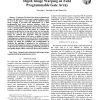135
click to vote
IJVR
2007
15 years 25 days ago
2007
—When a virtual environment system prevents a user’s avatar hand from penetrating virtual objects, the seen and felt positions of the hand separate. We propose a new method for...
125
click to vote
IJVR
2007
15 years 25 days ago
2007
—To construct 3D virtual scenes from two-dimensional images with depth information, image warping techniques could be used. In this paper, a novel approach of cylindrical depth i...
IJVR
2007
15 years 25 days ago
2007
—In this paper we report about the use of computer generated affect to control body and mind of cognitively modeled virtual characters. We use the computational model of affect A...
103
click to vote
IJVR
2007
15 years 25 days ago
2007
—This paper reports on the results of an experiment designed to study fine grain physiological responses of participants to an immersive virtual simulation of an urban environmen...
104
click to vote
IJVR
2007
15 years 25 days ago
2007
—The International Conference (series) on Disability, Virtual Reality and Associated Technologies (ICDVRAT) this year held its sixth biennial conference, celebrating ten years of...
124
click to vote
IJVR
2007
15 years 25 days ago
2007
—This article describes the design of the two application scenarios of the Virtual Human project and its integration into the Virtual Human system. This includes overall concepts...
112
click to vote
IJVR
2007
15 years 25 days ago
2007
—We present an empirical usability experiment studying the relative strengths and weaknesses of three different occlusion management techniques for discovering and accessing obje...
131
click to vote
IJVR
2007
15 years 25 days ago
2007
—Virtual Human (VH) creation aims to provide virtual characters with realistic behavior, which implies endowing them with autonomy in an inhabited virtual environment. Autonomous...
108
click to vote
IJVR
2007
15 years 25 days ago
2007
—There-reality environments are those virtual environments which evoke the same perceptual response from a viewer as if they were actually present, or there, in the real scene be...
121
click to vote
IJVR
2007
15 years 25 days ago
2007
—One of the biggest obstacles for constructing effective sociable virtual humans lies in the failure of machines to recognize the desires, feelings and intentions of the human us...

